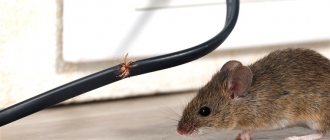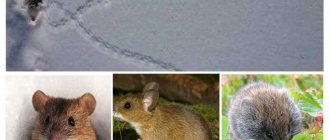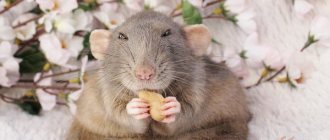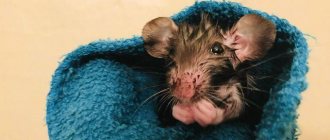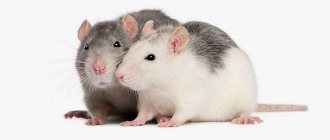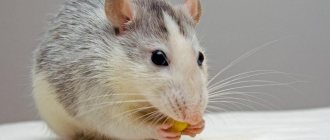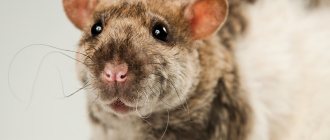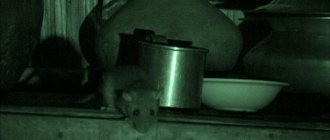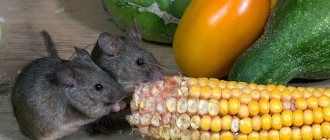Mice and rats are the most common types of rodents that can be found almost anywhere in the world. Despite the apparent similarity, these animals differ from each other both in external signs and in behavior. Many people choose mice as pets. These animals quickly find contact with humans and easily get used to their home environment. Rats remain primarily inhabitants of the wild.
There are quite a lot of differences between these animals
Similarities and differences between rats and mice
At first glance, the difference between these rodents is only in size: rats, as a rule, are somewhat larger and larger than mice. However, in reality, there are much more differences. Very often people confuse these animals, considering them almost identical animals.
Mice and rats: general features of life
Both species of rodents live on almost every continent, with the exception of the most northern latitudes - Antarctica and the North Pole. In addition, these animals are almost never found high in the mountains, preferring to live on the plains.
In places with a cool climate, mice and rats try to stay close to people, populating forests and fields close to people’s homes. From time to time, rodents visit basements, barns where livestock are kept, and the houses themselves. This is usually done in search of food.
In warmer regions, these animals live separately from humans, finding food on their own without any problems.
Such animals are predominantly nocturnal, but domestic mice easily adapt to human routines, staying awake during the day and resting at night.
This type of mammal is distinguished by its great mobility, running quickly, swimming and jumping high, as well as its body plasticity: rats, like mice, can easily crawl into the smallest hole.
In the wild, this type of animal forms entire colonies with a leader and a clear hierarchical system.
Despite existing stereotypes, rats and mice are very clean animals. They are very careful about the cleanliness of their home, leaving pieces of dust or droppings only as special identification marks.
Important. Taming a wild animal should be done with great care, as many wild rats and mice can be carriers of dangerous diseases. If you want to have such an animal at home, it is best to contact a pet store that will help you purchase a healthy pet.
Both animals have sharp incisors
Similarities and differences in appearance
At first glance, you can distinguish a rat from a mouse by the size of the body, because the mouse seems to be a miniature copy of a rat. Indeed, there really are similarities between these types of rodents.
Similarities in appearance:
- both species of these mammals have fairly long tails, which are covered with small sparse hairs and scales;
- both rats and mice have a specific muzzle: slightly pointed, with small rounded ears, black or red eyes and whiskers;
- A distinctive feature that unites this type of rodent is the presence of sharp incisors, as well as the absence of fangs. The teeth of these animals grow throughout their lives, so the animals constantly need hard objects on which to sharpen their teeth.
Differences in external features:
- size. Rats usually reach about 30 cm in length, not including the length of the tail. Mice grow about 9-10 cm in length;
- weight. Rats weigh much more than their smaller counterparts: the weight of a rat, as a rule, fluctuates around 600-650 grams, and the weight of mice does not exceed 30 grams;
- rhythm and way of life. Mice usually sleep in fits and starts, 30-45 minutes at a time, falling asleep about 20 times a day. Rats prefer to sleep for a long time, but only once a day.
Reference. In addition to external characteristics, there is a specific difference between these animals, which lies in the number of chromosomes. Thus, rats have 22 chromosomes, while mice have 20. For this reason, crossing these types of rodents with each other is impossible.
Behavior of rats and mice: similarities and differences
A big difference between these animals can be seen by observing the behavior of the animals. As a rule, rats are more aggressive than mice and in some cases are able to attack first.
Behavioral Similarities:
- both types of rodents, living in the wild, can prey on other mammals or insects;
- in natural conditions they live in burrows with complex passages and labyrinths;
- caution and attentiveness are a characteristic feature of the behavior of these animals.
Differences in behavior:
- rats prefer to hunt in packs, while mice usually do it alone;
- Mammals are often the prey of rats. Mice typically hunt insects;
- mice are considered more timid animals;
- Mice move at a run, leaving behind many traces. Rats move by jumping, trying not to make tracks.
In addition, there is a difference in the diet of these types of mammals: rats have a predatory instinct to a much greater extent than their smaller counterparts. These animals love meat, while mouse colonies feed mainly on plant foods.
At home, such a rodent should be fed grains, vegetables and fruits. You can give boiled chicken breast, cottage cheese and hard-boiled egg white. It is prohibited to feed the animal raw meat, cheese, as well as spicy, fatty or smoked foods.
Reference. Mice and rats are very difficult to get along with each other, being practically enemies of each other. The reason for this is the natural instinct of larger rodents, which forces them to hunt small relatives: often mice become victims of rats. That is why such animals cannot be kept in the same cage.
Which would you have - a mouse or a rat?
Mice adapt easily in captivity
What do the tracks look like?
What do rodent tracks look like?
The imprint of a rat's front paws on wet ground or snow is approximately 1.5 x 2 cm in size. You can see traces of 4 toes, which are widely spaced. The hind legs are larger (up to 4 cm), however, during movement, a small imprint remains - 2x2 cm, i.e. the mark is only partially visible. If the animal moves slowly, a thin chain of prints will remain on the surface. During the jump, the rat leaves rare traces - at a distance of up to 1.5 m.
The paw prints of mice during a jump are characterized by a smaller step (up to 30 cm). The tracks form a kind of trapezoid: when moving, the mouse places its hind legs wider, pushing off with its front, closely spaced legs. As a result, the tracks of the hind paws remain in front, and the tracks of the front paws remain behind. In addition, a thin line is visible behind - from the tail.
Who is smarter - rats or mice?
The intelligence of rats is considered higher than the intelligence of mice: large rodents are much more difficult to catch, they easily bypass all kinds of traps, showing miracles of courage, caution and cunning. Even if this animal gets into trouble, it will always give a sign to the other members of the colony, who will subsequently begin to bypass the dangerous place.
Caution will prevent this rodent from eating poison, while a mouse can easily mistake a poisoned treat for a treat.
These animals carefully check the area before moving in, sending the strongest, most cunning and hardiest individuals for inspection. In a rat colony there is a strict hierarchy, for ignoring which the animal can be expelled.
Rats are able to overcome many obstacles by working together perfectly and harmoniously. These animals can even come up with their own games and entertainment.
Mice, in turn, adapt more easily in captivity and become an excellent friend and companion for humans.
How are rodents harmful?
Rats are pests. The very rapid reproduction of rats causes serious damage to both farmers and villagers, and residents of the metropolis. Here's why rats are dangerous in the country:
- carry severe infectious diseases: plague, tuberculosis, brucellosis, leprosy, rabies, typhus, hepatitis, etc.;
- these animals destroy food products in warehouses and factories;
- eat feed from farm animals and birds;
- chew floors and walls of premises;
- damage electrical cables and various devices;
- contaminate food products with helminths and salmonella.
Rats adapt well to any conditions, and they are very tenacious. These animals cause a lot of inconvenience to people and carry dangerous diseases, so it is necessary to get rid of them without pity in all possible ways.
Differences between cubs: what do a mouse and a rat have in common
The main way to distinguish a mouse from a baby rat is a visual inspection of the animal, including examination of the tail and its length, the shape of the muzzle and ears, as well as the condition of the animal’s fur.
Little mouse or little rat: who grows faster?
Since the metabolism and rhythm of life of a mouse is higher and faster than that of a rat, their lifespan is almost 2 times shorter. Moreover, as they grow, these two types of rodents develop almost identically. Both individuals can begin to reproduce new offspring when they reach 1.5 months.
It is quite difficult to distinguish baby rodents
External differences between a mouse and a rat
It is quite difficult to distinguish the young of these two types of rodents, because the weight and height of the babies will not differ much. For this reason, it is necessary to examine the animal very carefully and carefully, noting the features of the shape of the head and body.
Differences between a mouse and a rat:
- rat pups have a longer tail, which in size reaches the length of the entire body. The tail of baby mice, in turn, is shorter, reaching about 50% of the length of the body;
- the tail of the baby rats is distinguished by its thickness and power, unlike its small relatives;
- The muzzles of the little mice have a more rounded shape. In rat pups, the head is slightly elongated and oblong;
- The body of small animals, as a rule, looks rounder. In addition, baby mice usually adopt a position of curling up into a ball. Rats prefer to rest with their torsos straightened and their paws stretched out;
- to the touch, the fur of a small animal is softer and more delicate, and the fur of baby rats resembles rough pile;
- The shape of the ears of mice is more rounded and rounded, and the ears themselves look thinner than those of rats. The ears of baby rats are usually a little sharper and thicker.
The lifespan of mice and rats at home is about 1.5-2 years and 2-3 years, respectively.
Difference in appearance
The shades of fur in rodents can be similar. And the body structure too. But there are significant differences.
| Options | Rats | Mice |
| Body size | Up to 25 cm length | 7-10 cm |
| Adult weight | 220-250, males 450 g | 45-85 grams |
| Muzzle shape | Long muzzle, small eyes | Triangular muzzle, large, nimble eyes |
| Ears | Small, slightly covered with villi, triangular | Round ears, hairless and mobile |
| Paws | Powerful, muscular, with webbed toes | Small, flexible, with tenacious claws. |
| Tail | Short, bristly ½ of body length | Long, thin, ¾ length |
| Wool | Rough, sparse, visible skin | Silky, soft, grows in a thick cover. |
Nutritional Features
The small rodent eats the same food as other members of the mouse family. The basis of the diet in the summer consists of small insects, caterpillars, larvae, and plants. With the onset of spring, small mice willingly eat fresh sprouts and young buds of bushes and trees.
In cold weather and throughout the year, small rodents eat seeds of cereals and legumes, corn, sunflowers, and fruits of trees and shrubs.
If a baby mouse goes into holes for the winter, it makes a reserve. However, more often small rodents accumulate in barns, warehouses, haystacks and granaries.
Pregnancy
Pregnancy in mice is indicated by the absence of another estrus. An attentive owner will definitely notice changes in the behavior of the rodent while bearing cubs. Some animals become calmer, others, on the contrary, become irritable or even aggressive.
Until almost the middle of pregnancy, it is impossible to determine that the mouse is carrying cubs in the womb. The rodent looks normal except for the fact that its appetite is slightly increased. The mouse walks smoothly and carefully. Motor activity decreases slightly. In the second half of the term, the abdomen increases in size. Shortly before birth, you can feel the fruit inside.
During pregnancy, mice experience toxicosis:
- the female loses her appetite;
- looks lethargic;
- eyelids drooping;
- drool flows from the mouth;
- sometimes there are cramps.
Important! Toxicosis cannot be treated. A mouse that bears offspring needs to be provided with complete rest, since the main cause of this pathology is stress.
How many babies does a mouse carry?
The gestation period in mice lasts 18-24 days. The duration of gestation depends on how many cubs are in the womb. The greater the number of pups, the faster the birth will begin. The length of gestation can also be affected by the conditions under which the rodent is kept.
In a favorable environment and with good nutrition, the mouse waits 20-22 days for the birth of its cubs.
Caring for a pregnant mouse
From the home of the mouse that carries the cubs, everything unnecessary is removed - the wheel, the tunnels. Access to the second level is limited.
About 10-12 days before giving birth, the mouse begins to build a nest. To do this, she will need pieces of fabric, napkins and paper. The rodent carries all this into the house. If until now the animal did not have a private place in the cage, the owner must equip it. It is there that the mouse gives birth to her pups and takes care of them.
The temperature and humidity in the room should remain approximately the same level. Do not disturb the mouse unnecessarily. Even cleaning the cage during pregnancy is done less often than usual. No noise or contact with other animals is allowed.
Despite the fact that the mouse needs rest, motor activity is not limited. The expectant mother is not prohibited from walking outside the cage, but only under the supervision of the owner.
5-6 days before the birth of the cubs, you need to do a general cleaning of the mouse’s home. All equipment and trays are thoroughly washed and disinfected with boiling water. It is better not to touch the nest if the female has already managed to equip it. If the male was still in the cage with the pregnant mouse, he should be removed.
If this is not done, he can impregnate the female within a few hours after birth.
Feeding
In the first half of the gestation period, the mouse's daily food intake is increased by a third, and in the second half, it is doubled. In addition to the grain mixture, the female should receive vegetables, fruits and fresh herbs. Since calcium and protein are needed for the development of cubs, low-fat cottage cheese, eggs and milk are introduced into the diet.
A glucose solution is added to drinking water. There should be a lick stone in the cage, with the help of which the mouse satisfies the increased need for minerals.
Interesting Facts
Like any other species, the baby mouse has several very interesting behavioral features:
- This unusual little rodent always hangs its nests on blades of grass half a meter above the ground. For the new offspring, the mother mouse builds a separate airy home. In some areas of the Caucasus, these mammals can be seen even at an altitude of up to 2200 meters.
- The weight of a newborn rodent does not even reach a gram.
- The little mouse is an excellent swimmer.
- Surprisingly, with the onset of winter, the rodent does not hibernate.
- These mice are quite voracious. Within 24 hours, one individual can eat up to 5 grams of food.
- In nature, they are carriers of certain diseases. Among them: leptospirosis, tick-borne encephalitis and tularemia.
Intelligence difference
Rats differ from mice by a much higher level of intelligence. This manifests itself in almost all areas, for example:
- rats learn from each other’s experiences, transmit signals of danger, and are able to analyze the situation, so they rarely fall into traps;
- rats are easy to train and can come up with games themselves;
- there is a clear hierarchy and order in the rat pack;
- rats always evaluate new territory and prepare escape routes in case of danger.
Mice are much inferior to rats in mental abilities, so it is much easier for humans to fight them.
Methods of disposal
To prevent the settlement of large colonies of rodents, it is necessary to promptly remove garbage and plant remains from the area.
It is advisable to dig up the soil by the time autumn approaches. If mice have already settled on the site, then in order to rid your home and storage areas of these rodents, you can go in two ways. The first of them is more humane and is based on the intolerance of some odors by these mice. If you place some plants in the pest holes, you can survive the small pests without harming them. Such plants are:
- elder;
- garlic;
- mint;
- sagebrush;
- black root;
- imperial hazel grouse.
You can also use chemicals, such as kerosene or ammonia. They should not be poured into the hole from the bottle. Simply soak a piece of cotton wool in the liquid and place it in the rodent’s home. He will leave him and never return.
If humane methods for one reason or another do not bring the desired result, then you can take a more cruel route, using resources such as:
- mousetraps;
- ultrasonic repellent devices;
- I;
- ash;
- cats.
Mousetraps and cats are commonplace, but this cannot be said about ultrasonic repellers. They can be easily purchased in specialized stores. The principle of operation is to produce sounds that are inaudible to humans, but painful to the sensitive ears of rodents. The voles will not be able to tolerate it and will leave the area. For certain reasons, they also try to avoid ash.
The field mouse is quite cute in appearance, you can see this just by looking at its photo. But its pleasant appearance absolutely does not justify the irreparable harm it causes to agriculture. Therefore, one cannot but rejoice at the fact that although it appears easily, getting rid of it will not be particularly difficult.
Habitat
This rodent can take root almost anywhere: in a field, in a meadow, in a forest. The only criterion for the area inhabited by baby mice is the abundance of grass, and it is desirable that it be tall. In it, a mouse can build a nest and feed itself. The nests of these animals are spherical and look like a real work of art. The little ones love to climb the stems of plants, which is not particularly difficult for them, because they weigh very little, and they also have a very tenacious tail.
Determination of spoiled products
As a rule, these rodents have their own food preferences, so by looking at spoiled foods it will be possible to determine who exactly caused the harm:
- If large representatives get to the cereals, they will not sort through the grains and will not leave traces of their presence, but they will not eat small, spoiled grains, only good ones, and will also leave behind husks.
- If small rodents find a food source, they will feed in one place, without going in search of new ones, while rats feed from different sources, for this reason they cause serious damage to the entire household.
Being around rats and mice will not bring anything good, so if you discover an infestation, you should take action immediately. In addition to the damage they cause, they are carriers of infection, which poses a danger to human health.
They multiply very quickly, so giving them time will significantly complicate the upcoming fight against them. If you cannot cope with them on your own, it is better to contact specialized services that will quickly get rid of the problem and give recommendations regarding the protection of premises.
Nowadays there is a wide range of different drugs on sale that make it possible to quickly and effectively get rid of pests. You should always remember that these drugs contain toxic substances, so you need to work with them very carefully, follow the instructions for use and be sure to adhere to safety measures. Do not allow children and pets to come into contact with the drug.
